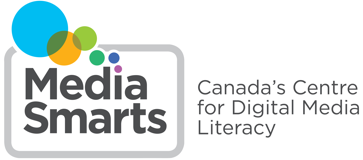Outcome Chart - Ontario - Communication
Overall Expectations:
Communication involves receiving and expressing meaning (e.g., through reading and writing, viewing and creating, listening and speaking) in different contexts and with different audiences and purposes. Effective communication increasingly involves understanding local and global perspectives and societal and cultural contexts, and using a variety of media appropriately, responsibly, safely, and with a view to creating a positive digital footprint
Specific Expectations:
- Students communicate effectively in different contexts, orally and in writing, using a variety of media.
- Students communicate using the appropriate digital tools, taking care to create a positive digital footprint.
- Students ask effective questions to acquire knowledge; listen to all points of view and ensure that those views are heard; voice their own opinions; and advocate for idea
MediaSmarts Resources
K-3
- Adversmarts: Understanding Food Advertising Online
- Break the Fake: What's in the Frame?
- Break the Fake: What's Real Online?
- Can You Spot the Ad?
- Eating under the Rainbow
- Facing TV Violence: Rewriting the Script
- Finding Balance in Our Digital Lives
- Girls and Boys on Television
- Healthy Food Web
- Internet Time Capsule
- Looking at Food Advertising
- Looking at Newspapers: Introduction - Lesson
- Once Upon a Time - Lesson
- Packaging Tricks - Lesson
- Prejudice and Body Image
- Representing Ourselves Online
- So Many Choices!
- Teaching TV: Film Production: Who Does What?
- Thinking About Television and Movies - Lesson
- TV Stereotypes
- Violence in Sports
4-6
- Avatars and Body Image
- Behaving Ethically Online: Ethics and Empathy
- Break the Fake: Verifying Information Online
- Break the Fake: What's Real Online?
- Comic Book Characters
- Cop Shows
- Editing Emotions
- Game Time
- Getting the Toothpaste Back into the Tube
- Girls and Boys on Television
- Images of Learning
- Know the Deal: The Value of Privacy
- Looking at Newspapers: Introduction - Lesson
- Looks Good Enough to Eat
- Media Kids
- Media literacy key concepts Introduction: What is media anyway?
- Media literacy key concepts Lesson 2: Media are constructions
- Media literacy key concepts lesson 6: Each medium is a unique aesthetic form
- Once Upon a Time - Lesson
- Online Marketing to Kids: Protecting Your Privacy
- Online Marketing to Kids: Strategies and Techniques
- Prejudice and Body Image
- Teaching TV: Film Production: Who Does What?
- The Constructed World of Television Families
- The Hero Project: Authenticating Online Information
- Thinking About Television and Movies - Lesson
- Tobacco Labels
- TV Stereotypes
- Understanding the Internet Lesson 2: Pathways and Addresses
- Understanding the Internet Lesson 3: Build Understanding
- Understanding the Internet Lesson 4: Communication and Social Media
- Video Production of a Newscast
- Villains, Heroes and Heroines
- Violence in Sports
- Winning the Cyber Security Game
7-8
- Behaving Ethically Online: Ethics and Values
- Bias and Crime in Media
- Break the Fake: Verifying Information Online
- Buy Nothing Day
- Celebrities and World Issues
- Comic Book Characters
- Cyberbullying and Civic Participation
- Editing Emotions
- Gender Stereotypes and Body Image - Lesson
- Getting the Toothpaste Back into the Tube
- Know the Deal: The Value of Privacy
- Looks Good Enough to Eat
- Marketing to Teens: Gender Roles in Advertising
- Marketing to Teens: Marketing Tactics
- Marketing to Teens: Talking Back
- Online Marketing to Kids: Protecting Your Privacy
- Privacy and Internet Life: Lesson Plan for Intermediate Classrooms
- Put Your Best Face Forward
- Setting the Record Straight: Public Service Announcements on Mental Health
- Television Broadcast Ratings
- That's Not Cool
- The Girl in the Mirror
- The Impact of Gender Stereotypes
- The Price of Happiness
- Understanding Cyberbullying : Virtual vs. Physical Worlds
- Unpacking Privilege
- Up, Up and Away? (TM)
- Video Production of a Newscast
- Watching the Elections
- What Students Need to Know about Freedom of Information and Protection of Privacy (Grade 5) - Lesson
- Where's The Line? Online Safety Lesson Plan for School Resource Officers
- Winning the Cyber Security Game
- Writing a Newspaper Article
9-12
- Art Exchange
- Bias in News Sources
- Dealing with Digital Stress
- Digital Outreach for Civic Engagement
- Digital Storytelling for Civic Engagement
- Diversity and Media Ownership
- Film Classification Systems in Québec
- First Person
- First, Do No Harm: Being an Active Witness to Cyberbullying
- Free Speech and the Internet
- Images of Learning
- Kellogg Special K Ads
- Making Media for Democratic Citizenship
- Miscast and Seldom Seen
- Online Relationships: Respect and Consent
- Privacy Rights of Children and Teens
- Reality Check: Getting the Goods on Science and Health
- Reality Check: We Are All Broadcasters
- Secure Comics
- Suffragettes and Iron Ladies
- Technology Facilitated Violence: Criminal Case Law
- The Blockbuster Movie
- The Citizen Reporter
- The Pornography Debate: Controversy in Advertising
- The Privacy Dilemma: Lesson Plan for Senior Classrooms
- There's No Excuse: Confronting Moral Disengagement in Sexting
- Transgender Representation in TV and Movies
- Who's Telling My Story?
- Unpacking Privileg
